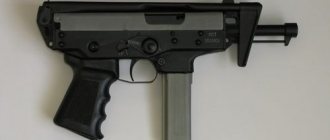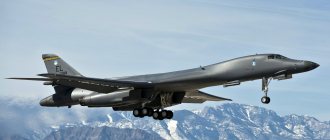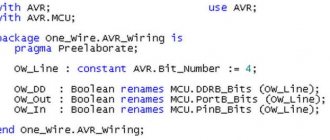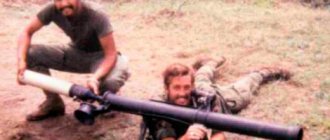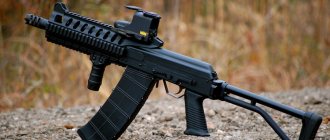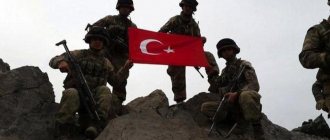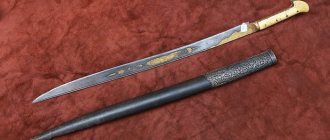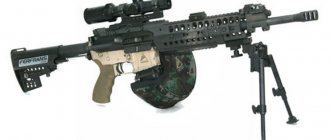The Su-22 is a Russian fighter produced in the mid-70s, widely exported to various “hot spots” of the world. At that time it had good flight performance and combat characteristics.
History of the creation of the Su-22
Due to the shortage of Al-21F3, the USSR leadership needed to find an alternative to replace it. In 1975, by order of P.V. Dementyev's prototype Su-22, which was designated S-32M2, was equipped with R-29BS-300 turbojet engines with a thrust of 11,500 kgf in afterburner and 8300 kgf at maximum. At the beginning of 1975, factory tests of this modification of the aircraft began. After their successful completion, the fighter began to be exported under the serial name Su-22.
The release of this modification contributed to the process of standardization of the USSR military aviation fleet, which included front-line aircraft with foreign engines. The fighters that were equipped with an imported power plant in their design also included the MiG-23. The distinguishing features of these two models are: a relatively short rear fuselage, different placement and dimensions of the air intakes that cool the turbojet units, compared to the Su-17M2. The result of changes to the tail section of the Su-22 was an increase in the span of the stabilizers and the height of the fighter due to the raising of the keel.
Similar to previous upgrades (Su-17M3 and Su-17M), this model was also intended for export. In April 1977, the state testing program on the combat training S-52UK was completed. In 1977-1978 50 Su-22 fighters were exported to Libya, Vietnam, Syria, Iraq, Angola, Afghanistan, Peru, Romania and Yemen. The aircraft was equipped with an R29BS-300 engine, a modernized state identification system transponder and an R-802B radio station. Since 1984, by equipping the Su-17M3 design with AL-21F-3 engines, about a hundred vehicles have been sold to eleven countries around the world.
The improvement of the equipment of the Su-17M4 and the use of various weapons on it in the export modification of the Su-22M4 were able to interest regular buyers of Soviet weapons. Over the entire history of serial production, this fighter, in total quantities of more than 350 units, was received by the air forces of eighteen countries around the world. In various modifications, the Su-22 was in service with the Soviet Air Force, from where it was withdrawn only in the mid-90s.
History of the creation of the SU-22
su-7
In the mid-60s, the Su-7B and the designers were given a new task - to find ways to reduce the takeoff and landing distance for this type of aircraft. They tried to solve this problem with the help of launch boosters and braking parachutes, but soon came to the conclusion that a wing with variable geometry was needed. By making only the outer section rotatable and thereby maintaining minimal displacements of the centers of pressure and gravity when changing geometry, the developers left the Su-7B .
The first aircraft in the history of Soviet aircraft construction with variable wing geometry was designated S-22I and first took flight on August 2, 1966. Later, state tests began and after their completion in November 1967, the car was recommended to be put into production.
Serial production of the Su-17 (this designation was given to the aircraft) began only in 1969. The most popular series was the Su-17M with the AD-21F-3 engine. In 1975, the vehicle was equipped with the latest weapons control equipment with a laser rangefinder and the KN-23 navigation system, which solved the problem of flying to the target and back in automatic mode.
FIGHTER-BOMBER AIRCRAFT
In the early 80s, a new modification of the Su-17M was developed - the Su-17M5 with a fixed wing with a sweep of 40-45° (“proprietary” designation S-54N, i.e. “Fixed wing”).
It also received influxes and active mechanization. On the new aircraft they planned to install more powerful (by 1500 kgf) and economical (by 15%) AL-31F turbofan engines and an in-flight refueling system. At the same time, the fuel supply without PTB increased to 5 tons, which, combined with the efficiency of the engines, should have ensured an increase in flight range, improved performance characteristics and an increase in the mass of the combat load. Also, the Su-17M5 was supposed to receive new artillery weapons and conformal ventral suspension points for aircraft weapons.
In addition to improving the avionics, the Su-17M5 was to receive an Orlan laser-television station, an indicator for transmitting information to the windshield, as well as new equipment suspended in ventral containers.
Su-17M5 was supposed to get a new wing flap
In Komsomolsk-on-Amur, a mock-up of the Su-17M5 was built, which found support from military testers, but not from the top military leadership and the leadership of the MAP. Representatives of the Air Force Research Institute at the end of 1985 even turned to the Politburo of the CPSU Central Committee for support, but to no avail. By that time, the military leadership was already very interested in the Sukhov Su-37.
In the Su-17M6 (S-56) version, the wing received a sweep of about 45°. A number of sources indicate that a version of the Su-17M7 has also been developed.
There were also plans for a much less radical (compared to the Su-17M5) modernization of the MiG-27 by installing an AL-31F engine on it.
Aircraft design
Design of Su-22, Su-17
The aerodynamic layout of the Su-22 is traditional - it is a monoplane with a mid-wing and a tail unit consisting of a fin with a rudder and a stabilizer. The wing with variable geometry from 300 to 630 is equipped with slotted flaps installed in the fixed part. Sealed fuel tanks are mounted in the wing consoles, and the NR-30 .
The tail section contains the stabilizer and fin, four air brakes and a braking parachute compartment. There is a gargrot on top of the fuselage from the cockpit to the fin. The fighter-bomber's chassis is three-legged, the front strut retracts forward against the flow, and the main supports into the fixed part of the wing are perpendicular to the flow.
The sealed compartment of the bow contains a pilot's cabin with a glass canopy with bindings; the frontal part is made of armored glass. The folding part of the canopy opens up and back at an angle of 500. The pilot sits in the K-36D ejection seat. The instrument panel has analogue indicators that inform the pilot about the spatial position of the aircraft and the operation of the equipment and engine.
The Su-22M-4 is equipped with the new ARK-15, the RSBN-2S has been replaced by the RSBN-5, and a new sighting and navigation system with a laser rangefinder and television system has been installed.
FRONT BOMBER AIRCRAFT
Heavy aircraft-carrying cruiser "Admiral Kuznetsov": history of creation, advantages and disadvantages, combat use
Since 1977, the Sukhoi Design Bureau has been working on the Su-24BM (T-6BM) project (major modernization) - a deep modernization of the Su-24. However, sometimes the designation is found of this Su-30 project (the first with this name).
At the same time, the vehicle was increased in size (this was especially true for its width, since the bomb bay was supposed to be placed between the engines). The design of the air intakes also changed: they were located under the wing. The car was planned to be equipped with two AL-31F turbofan engines. The composition of its avionics had to change, the range of weapons used should have been expanded, and the characteristics of the anti-aircraft guns had to be improved. The preliminary design of the Su-24BM, completed under the leadership of lead designer V.F. Marov, was completed in 1981. At the same time, a full-scale model of the future aircraft was built. The acceptance certificate for the preliminary design and layout was approved by the Commander-in-Chief of the USSR Air Force, Chief Air Marshal P.S. Kutakhov. Only the signature of I. S. Silaev, Minister of Aviation Industry of the USSR, remained.
Next - a word about the decisive moments of the “biography” of the Su-24BM to aircraft designer O.S. Samoilovich, then working at the Sukhoi Design Bureau:
Initial version of Su-24BM
Thus, at that moment, the management of the Sukhoi Design Bureau made a “bet” on a completely new project - the T-60, which began to “squeeze” the Su-24BM. In addition, the military made a number of proposals to further expand the capabilities of deep modernization. Therefore, in 1981, work began with renewed vigor: supporters of the modernization of the Su-24 replaced the variable-sweep wing with a fixed one, the single-fin tail became double-finned, and the composition of the avionics also changed significantly. In 1983, a full-size mock-up of the Su-24BM2 (T-6BM2) aircraft was built, and the preliminary design was successfully defended (1982), but the management of the Sukhoi Design Bureau and MAP decided to “promote” the T-60 project...
Improved version of Su-24BM
Since 1985, OKB im. P. O. Sukhoi began work on further modernization of the Su-24 aircraft, as a result of which a modification of the Su-24MM (small modernization) was created. One of its authors was V. R. Kovtun.
Su-24MM
The new version of the Su-24 was supposed to be equipped with new, more economical AL-31F turbofan engines, which, in combination with the MVM increased by 2 tons, should have led to a significant increase in the vehicle’s flight range. A characteristic feature of the vehicle’s appearance is the presence of a third, additional air intake located on the top of the fuselage (it was necessary for new engines). At the same time, the composition of avionics and the range of weapons used have changed slightly.
Its second option, actively “promoted” by representatives of the Air Force, involved the use of conformal tanks.
Subsequently, work on the project was interrupted because... The Customer was not particularly interested in it, and the OKB management preferred to develop the Su-27IB program (the future Su-34).
According to the recollections of veterans of the Sukhoi Design Bureau, if it were not for the cessation of work on improved versions of the Su-24, the Soviet Air Force would have had 150-200 new aircraft, significantly superior in their capabilities to the Su-24M.
Tactical and technical data
- The length of the aircraft is 18.86 m.
- The height of the aircraft is 4.86 m.
- The empty weight of the aircraft is 10445 kg.
- Maximum take-off weight - 18820 kg.
- Fuel capacity - 3770 kg.
- Powerplant - 1 TRDF R-29B-300.
- The maximum ground speed is 1350 km/h.
- The maximum speed at altitude is 2230 km/h.
- Practical ceiling - 14 thousand m.
- Range - 2500 km.
- Combat radius - 590 km.
- Armament - 2 x 30 mm HP-30 with a supply of 300 shells each.
- Combat load - 3800 kg at 8 hardpoints, 8 air-to-air missiles R-60, K-13; Air-to-surface missiles Kh-25MR, Kh-25MP, Kh-29P, Kh-29T; unguided missiles S-5, S-8, S-13, S-24; adjustable bombs KAB-500, KAB-1500; free fall bombs with a caliber of up to 500 kg.
Modifications
- Su-17
- the first production version; Until 1972, several dozen were produced. - Su-17M
- modification with AL-21F3 turbofan engine, increased fuel capacity, more advanced avionics, expanded range of weapons and some other changes; produced since 1972; - Su-17M2
- a variant with a fuselage nose section extended by 200 mm, new avionics and an expanded range of guided weapons; made its first flight in early 1974, serial production was carried out in 1975-79; - Su-17M3
– further development of M2; new sighting equipment was installed, the fuel supply was increased; produced since 1976; - Su-17M4
– variant with new avionics, non-adjustable air intake and some design changes in the fuselage; the prototype appeared in 1980, mass production was carried out in 1981-90; - Su-17M4R
– reconnaissance version; - Su-17UM
is a two-seat combat training aircraft equipped with avionics used on the Su-17M2; the prototype appeared in 1975, serial production was carried out in 1976-78; the design of the aircraft served as the basis for the creation of the Su-17M3; - Su-17UM3
is a two-seat combat training aircraft equipped with avionics used on the Su-17M3; produced since 1978; - Su-20
– export version of the Su-17M with simplified avionics and a reduced range of weapons; released in 1972, small series built; - Su-22
is an export version of the Su-17M2, equipped with a R-29BS-300 turbofan engine, which was later installed on aircraft of other export modifications; produced since 1976; - Su-22M
– export version of the Su-17M3; released 1977; - Su-22M3
- export version of the Su-17M3 with more advanced avionics compared to the Su-22; produced since 1982; - Su-22M4
– export version of the Su-17M4; AL-21F3 engine; produced since 1984; - Su-22U
- export. - Su-22UM
– export version of the Su-17UM; produced since 1976; - Su-22UM3
– export version of the Su-17UM3; production has been carried out since 1982; - Su-22UM3K
- a combat training version of the Su-22M4, also intended for export; produced since 1983
Operators
Su-22M3 aircraft are in service . Su-22M4 and three Su-22M3 entered service at the beginning of 1984 ; the service life of these aircraft is ending.
The Slovak Armed Forces operate 17 Su-22M4 and 3 Su-22UM3 , five of which are used as simulators and are no longer flown. After the division of Czechoslovakia, 34 Su-22M4 and 5 Su-22UM3 , but these machines are not currently in service.
The fate of the Iranian Su-22 , but it is unlikely that they can fly. There are at least 35 combat Su-22s and 4 training twins in Libya. On the American continent, Su-22s are in service only in Peru, and then the eleven aircraft received are in reserve. The Syrian Armed Forces in 1984 and after entered service with about 50 Su-22M and Su-22M4 and at least six training Su-22U .
MILITARY TRANSPORT AVIATION
M16 assault rifle: history, performance characteristics, combat use
The first attempts to create an extended version of the Il-76 (designated Il-176) date back to 1976 and appeared, obviously, under the influence of the creation of the C-141B aircraft by American aircraft designers. At the same time, it was found out that with the existing D-30KP engines, the aircraft has no advantages over the conventional Il-76. Since the late 70s, work has been carried out to create more powerful engines D-30KP-30 with a thrust of 14,000 kgf and D-30KP-30-17 with a thrust of 17,000 kgf. Subsequently, they returned to the extended version (with the D-30KP-30) in 1980, but full-fledged work, culminating in the creation of a real Il-76MF aircraft, began only in 1987. On September 1, 1995, the new aircraft made its first flight, and its state tests were completed on April 22, 2003.
Il-76MF
According to the memoirs of R. R. Gaziev, chief designer of TAPOiCh for modifications of the Il-76:
The IL-76MF received more powerful PS-90A-76 engines with a thrust of 14,500 kgf, new equipment, in particular, a new PNPK (sighting and navigation flight complex) “Kupol-3”. The cargo compartment was lengthened by 6.6 m, which ultimately made it possible to increase the flight range by 15-20%, payload capacity by 22 tons and reduce fuel consumption by 12%. The auxiliary power unit (APU) of the TA-6A was replaced by the VKTD-43, similar to that installed on the Tu-204. During testing (in the summer of 2000), the aircraft landed six P-7 platforms, and also used the inertial landing method (creating a pitching angle and shifting the platforms under its own weight). The crew of the aircraft was reduced to 5 people: the “services” of the on-board radio operator and the operator of the aft gun mount were abandoned.
A total of three Il-76MF were built: one experimental and two production ones for the Jordanian Air Force (in 2010-11), but all of them no longer fly. The first one is in storage on the territory of TAPOiCh, and the other two are in Jordan, being put up for sale. Unfortunately, the machines turned out to be very expensive in commercial use. Several IL-76MF fuselages remained unfinished in the TAPOiCh workshops.
It was also planned to continue work on improving the An-124: in the An-124M version (the designation An-122 is also given), it was planned to strengthen the design of the aircraft. At the same time, due to the use of advanced structural materials, the weight of the equipped Ruslan should have increased slightly. After strengthening the structure, it was planned to fully use the entire volume of the aircraft’s fuel tanks (even now this is not being done due to limitations in the aircraft’s design). Therefore, the amount of fuel on board increased from 213 to 250, and in the future - up to 300 tons. At the same time, the flight range of the modified vehicle with a load of 150 tons was supposed to be about 5000 km.
Combat use
The Su-17 received its baptism of fire in October 1973 as part of the Syrian Air Force: 15 Su-20s flew 98 sorties against Israeli military and industrial targets, incl. attacked the oil refinery in Haifa. 8 vehicles were lost, an enemy plane was shot down in air battles. The Syrians also used the Su-20/22 during the battles in June 1982 in southern Lebanon. Losses amounted to about 10 aircraft. Soviet Su-17s of various modifications were used during the Afghan war to strike Mujahideen detachments, caravans, infrastructure elements, etc. Airplanes of the Afghan government air force had a similar use, but there were cases of bombing of the territory of the USSR and Pakistan due to navigation errors. After the victory of the Mujahideen, a new round of civil war began, and the Su-20s were scattered among the warring factions and were again involved in hostilities between recent allies. Aircraft of the Angolan Air Force from the first half of the 80s. were used in combat operations against UNITA units and South African troops. Egyptian aircraft took part in a short-term conflict with Libya in July 1977. From 2 to 6 aircraft were lost. Libyan Su-22s were used in 1982-1987. during the fighting in Chad and Sudan, and were also “noted” in a number of incidents over the Mediterranean Sea involving, on the other hand, American aircraft. Losses amounted to about 5 vehicles. Iraqi fighter-bombers saw active service in the Iran-Iraq War and supported friendly forces during their invasion of Kuwait. During the fighting in January-March 1991, American fighters shot down 2 Su-22s. During the same period, the Iraqi Air Force used aircraft of this type against rebel Shiites in the south and Kurds in the north of the country. The last two vehicles on earth were destroyed. The South Yemeni Su took part in the battles of the civil war that broke out in this country in January 1986. After the formation of a united Yemen, another war broke out here in 1995, this time between the North and the South. The southerners again used their Su-20s. Peruvian Su-20s took part in a number of conflicts and armed incidents on the border with neighboring Ecuador, during which about 3 vehicles were lost. Airplanes were also involved in actions against the drug mafia. In 1994-95 Russian Su-17s were used in the Chechen war. The participation of Armenian Su-17s in the battles of the Karabakh conflict was also noted, while 1 aircraft was shot down by the enemy.
Armament
The combat load with a total mass of up to 4000 kg is suspended on 6 pylons: 2 fuselage and 4 underwing. The first production Su-17s did not carry air-to-surface guided weapons. In subsequent modifications, this drawback was eliminated, and 2 internal underwing pylons are used to suspend missile launchers or CABs of various types. At first the Su-17M was taken |Kh-23M|
and anti-radar
|X-28|
.
Later the range was expanded with the possibility of suspension |X-25|
and
|X-29L|
.
The Su-17M2 also carried all of the above systems. This modification was the first in the Su-17 family to receive the |R-60|
.
On the Su-17M3, the number of ventral pylons has been increased to 8. The Su-17M4 and Su-22M have ten external hardpoints (4 ventral and 6 underwing. At the same time, 2 central underwing pylons are intended exclusively for suspension of air-to-air missiles |P- 60|
), which can carry a combat load with a total mass of up to 4250 kg, including air-to-ground missiles with television or laser guidance of the type
|X-25M|
and
|X-29|
, anti-radar missiles type
|X-28|
and
|X-58|
, bombs, small cargo containers, outboard gun mounts, rocket launchers and other weapons.
Su-17M4 are capable of carrying the most diverse range of guided weapons: bombs |KAB-500L|
;
adjustable missiles |S-25L|
;
UR types |X-25ML|
/
|X-25MR|
,
|X-27|
,
|X-29L|
/
|X-29T|
;
anti-radar missiles |X-25MP|
,
|X-27|
,
|X-58|
.
All modifications are made in NURS blocks of types |S-5|
,
|S-8|
or
|S-13|
, as well as single NURS
|S-24|
and
|S-25|
.
Other types of suspended weapons include free-fall bombs of calibers from 100 to 500 kg; bomb cassettes |RBK-250|
and
|RBC-500|
, gun containers
|KMSU|
;
incendiary tanks. The SCHK is also equipped with 2 1156-l or 830-l PTBs. In the root part of the wing (according to other sources - in the center section) there are two cannons |HP-30|
(30 mm) with 80 rounds of ammunition per barrel.
To destroy ground-based radars, a container with the Vyuga
, providing target designation for anti-radar missiles
|X-28|
and
|X-58|
.
Interesting Facts
Su-17 aircraft became the first aircraft to drop nuclear bombs in a nose-up mode. To do this, the pilot performed a half-loop and at the top of the figure made a 180-degree flip, simultaneously releasing the combat charge. Then the pilot turned on the forced engine operation and quickly moved the plane away from the explosion point.
To train flight personnel in this type of bombing, the IAB-500 training bomb was used, which simulated the flash and dust “mushroom” of an atomic explosion.
At the peak of the use of the Su-17 aircraft in Afghanistan, up to 9 sorties were carried out per day. This was achieved by combining ground handling operations.
Expert assessment - which is better?
Some experts claim the superiority of one of the aircraft, but most take a neutral position. It is noted that in the near future it is impossible to determine which fighter is better due to lack of information. The theoretical capabilities of both aircraft are advanced. Among the opinions of experts, there is a theory that in a collision in a real battle there is a possibility of mutual destruction.
Su-57 and F-22 are considered heavy fighters. Both aircraft are capable of performing combat missions alone without ground support. Despite similar characteristics, their purposes are different. In theory, when using technical advantages, both the F-22 and the Su-57 are capable of emerging victorious from the fight.
